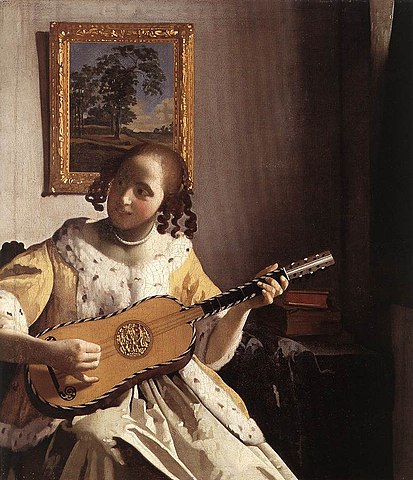I forgot to mention Kenwood's other great art treasure - this Vermeer of a girl playing a guitar (then considered a rather racy and novel instrument in the Netherlands). It's a fascinating, mesmerising work, but also faintly unsettling, and I can't say it's among my favourite Vermeers. I prefer the subtler, more nuanced handling of tone, colour and texture in the great interiors of the artist's middle period. The Guitar Player is a later work, with the colours lying together in sharply defined planes, rather in the manner of some early Manets. This gives an oddly photographic effect, as if the painting is the product of one of Vermeer's experiments with optical devices. The off-kilter composition is odd and hard to explain, and the painting lacks the peculiar luminosity and the character of stillness and meditative inwardness that gives the greatest Vermeers their extraordinary, quasi-spiritual power. This girl, her face flushed with pleasure, looks emphatically outward, not inward, grinning with simple, immediate pleasure as she plays. (And a grin was a rare thing in art, before Vermeer's compatriot Frans Hals made it his stock in trade.)
Just weeks after Vermeer's death, his widow, struggling to survive, was obliged to use this painting and A Lady Writing a Letter with Her Maid to settle a debt of 617 guilders with Delft's master baker.
In November 1818, John Keats wrote from Hampstead to his brother George: 'I must not forget to tell you that a few days since I went with Dilke a shooting on the heath and stot [shot] a Tomtit - There were as many guns abroad as Birds.'
On 16 August 1820 - six months before his death - Keats, in a letter to Shelley, wrote: 'I remember you advising me not to publish my first-blights, on Hampstead Heath - I am returning advice upon your hands. Most of the Poems in the volume I send you have been written above two years, and would never have been publish'd but from a hope of gain: so you see I am inclined enough to take your advice now...'
The volume Keats sent to Shelley was Lamia, Isabella & c. It was found, two years later, folded back in the drowned Shelley's pocket, and Leigh Hunt claimed that he tossed it onto the poet's funeral pyre (though, in point of sober fact, he seems to have stayed in the attendant carriage during the cremation).
Subscribe to:
Post Comments (Atom)


No comments:
Post a Comment